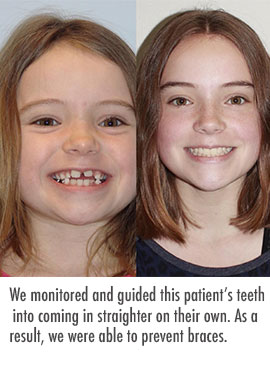Interceptive Orthodontic Treatment
Early Orthodontic Treatment for Children
Interceptive orthodontics is an approach that uses phased treatments to manipulate growth and correct developmental occlusion problems.

The Canadian Association of Orthodontics and the American Association of Orthodontists both recommend that children see an orthodontist as early as age seven to be evaluated for orthodontic treatment.
Interceptive orthodontic treatment (also known as Phase-One or Early Treatment) typically begins around age eight or nine. Phase Two will begin around age 11 or older. The goal of early treatment is to correct the growth of the jaw and certain bite problems, such as underbite. Early treatment also helps to make room for permanent teeth to come in properly, and lessen the odds of extractions in the future.
How to tell if your child may need early orthodontic treatment
- Early or late loss of baby teeth (your child should typically start losing teeth around age five, and will have all permanent teeth around age 13)
- Difficulty chewing and/or biting
- Mouth breathing
- Your child continues sucking his or her thumb after age five
- Speech impediments
- Protruding teeth (the top teeth and the bottom teeth extend away from each other)
- Teeth that don’t come together in a normal manner or even at all
- Shifting of the jaw when your youngster opens or closes the mouth (crossbites)
- Crowded front teeth around age seven or eight
Types of Interceptive Orthodontics
- Expansion of the upper jaw to eliminate a crossbite
- Expansion of one or both jaws to create space for overly crowded teeth
- Early removal of specific baby teeth to facilitate the proper eruption of permanent teeth
- Maintaining space for permanent teeth after the premature loss of a baby tooth
- Reducing the protrusion of upper incisors to decrease the likelihood of fracture from trauma
How will early treatment benefit my child?
Most children lose all their baby teeth by age 13. By the end of their teen years, the jaw bones will harden and stop growing.
Orthodontic procedures for adults often take more time and can entail tooth extraction or oral surgery. Receiving early orthodontic treatment as a child can help prevent the need for orthodontics as an adult, and leave little to no need for extraction or surgery in the future.
- Crowded teeth are much more difficult to brush and floss, which may contribute to tooth decay and periodontal disease.
- Protruding teeth are more susceptible to accidental chipping.
- Crossbites can result in unfavorable growth and uneven tooth wear.
- Open bites can result in tongue-thrusting habits and speech impediments.
If your son or daughter is between the ages of seven and eight and shows signs of needing orthodontic care, or you have been directed by your family dentist to visit an orthodontist, please contact our practice and schedule an appointment.
Our team will provide your child with an initial exam, and discuss with you the best steps to take toward caring for your his or her smile.


 Website Powered by Sesame 24-7™
Website Powered by Sesame 24-7™